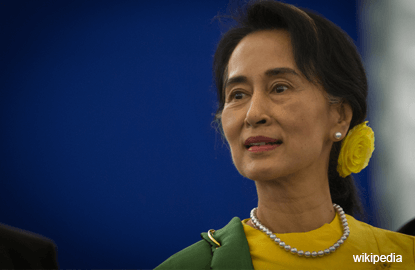
SINGAPORE (March 13): Myanmar has four currency rates, no credit rating, and a shiny new stock exchange that doesn’t yet trade.
Those are some pieces of the financial puzzle that Aung San Suu Kyi’s National League for Democracy inherited when it took control of Parliament on Feb. 1. After five decades of military rule, the former dissident’s party will need to grapple with those and other legacies of the country’s isolation.
Investors see potential in the country of about 56 million people. Myanmar has a capitalist culture—it developed a sophisticated black market during the junta’s rule—and natural resources. The country may end up being among the fastest-growing in the world this year: The International Monetary Fund forecasts an 8.4 percent increase in real gross domestic product in 2016. Meanwhile, the Central Bank of Myanmar is racing to put into place the financial infrastructure needed to cope with an expected influx of foreign investment and trade.
The central bank granted preliminary licenses to nine foreign lenders in October, including Australia & New Zealand Banking Group and Industrial & Commercial Bank of China. They’re expected to engage in institutional banking to facilitate the entry of foreign investors. The central bank has said it plans to award a second round of licenses this year.
Myanmar’s currency, the kyat, was pegged to the IMF’s special drawing rights basket for much of the junta’s reign. The official rate was set at about 6.4 kyat per dollar—which made it more than 100 times overvalued in comparison with rates available on the black market.
After the country started moving toward civilian rule, the central bank in 2012 introduced a managed float, initially setting the daily rate at 818 kyat per dollar. That regime is still in effect. Each morning, after commercial banks put in bids for the currency at an auction, the central bank announces a reference rate. Banks are then allowed to buy and sell kyat in a trading band of 0.8 percent on either side of that rate.
Commercial banks also have more competitive, unofficial currency rates that they use on the quiet. Then there’s the black market rate, which accounts for most transactions.
The central bank aims eventually to unify all four rates. Last year it started a slow depreciation of official rates. “The formal and informal exchange rates are now not much different,” says Win Thaw, the central bank’s deputy director general who heads its currency department. “It is below 1 percent. Some of the local banks and foreign banks that were awarded licenses have started forward and swaps trading.”
The reference rate as of Feb. 1 was 1,293 kyat per dollar. Traded only onshore, the kyat tends to be insulated from global market swings.
To see the Central Bank of Myanmar’s rates, run {CBMM} on the Bloomberg Professional service. For the country’s Treasury bills, go to {MYANMM <Govt>}. Four of Myanmar’s largest local banks contribute their spot, cross, and deposit rates. They are Myanmar Oriental Bank {MOBK}, KBZ Bank {KBZK}, Ayeyarwady Bank {AYAB}, and United Amara Bank {UABM}.
Modernizing the Economy
The army’s rule left Myanmar one of the poorest nations in Southeast Asia. As the country emerges from economic isolation, it will need $80 billion of power, transport, and technology projects through 2030 to modernize its economy, the Asian Development Bank estimates. Financing might be helped along by a credit rating. The government appointed Citigroup and Standard Chartered last year as its sovereign credit rating advisers, but Myanmar still has no rating.
Going Public
One thing Myanmar has is its own stock exchange. It was a long time coming. Daiwa Institute of Research Holdings, a unit of Japan’s second-largest brokerage, began laying the groundwork 20 years ago. After myriad delays, Myanmar opened the exchange in Yangon in December.
Six companies have been chosen to list, including two banks, according to the country’s Securities and Exchange Commission. First Myanmar Investment, a conglomerate controlled by businessman Serge Pun, aims to be among the first to trade, Pun has said.
Trading on the exchange is expected to begin in March. Foreign investors won’t have access at first. One of the fears is that the bourse ends up like exchanges in Cambodia and Laos, which have failed to take off. Optimists argue that Myanmar’s market has a better chance of success, given that its $66 billion GDP is more than three times that of Cambodia or Laos.
“Myanmar’s economy and population are not directly comparable to these nations,” says Melvyn Pun, a son of Serge Pun and a holder of First Myanmar Investment shares. “Myanmar has more than seven times as many people as Laos.” As part of preparation for the exchange, delegates from Myanmar visited Tokyo for “Stocks 101” classes taught by veteran Daiwa traders.
“There are many successful stock exchanges in the region,” says the younger Pun. “Ho Chi Minh City Stock Exchange, Thailand’s SET, and Bursa Malaysia can serve as positive examples.”